Comparing and Contrasting Motivation Theories in Business Essay
VerifiedAdded on 2020/10/22
|8
|1569
|321
Essay
AI Summary
This essay provides a comprehensive overview of motivation theories within a business context. It begins by defining motivation and its significance in stimulating and sustaining employee behavior. The essay delves into early motivation theories, including McClelland's theory, which focuses on the needs for achievement, power, and affiliation, and Herzberg's theory, which differentiates between intrinsic and extrinsic factors affecting job satisfaction and dissatisfaction. The essay then contrasts these early theories with contemporary models such as Equity and Expectancy theories, highlighting their differences and similarities. Furthermore, the essay addresses common organizational issues related to employee motivation, such as poor leadership, working environment, and lack of rewards, suggesting potential solutions like the application of ERG theory and Herzberg's Two-Factor theory. The conclusion emphasizes the crucial role of motivation in enhancing employee performance and the importance of understanding and applying various motivational theories to address organizational challenges effectively. References include various books, journals, and online resources.
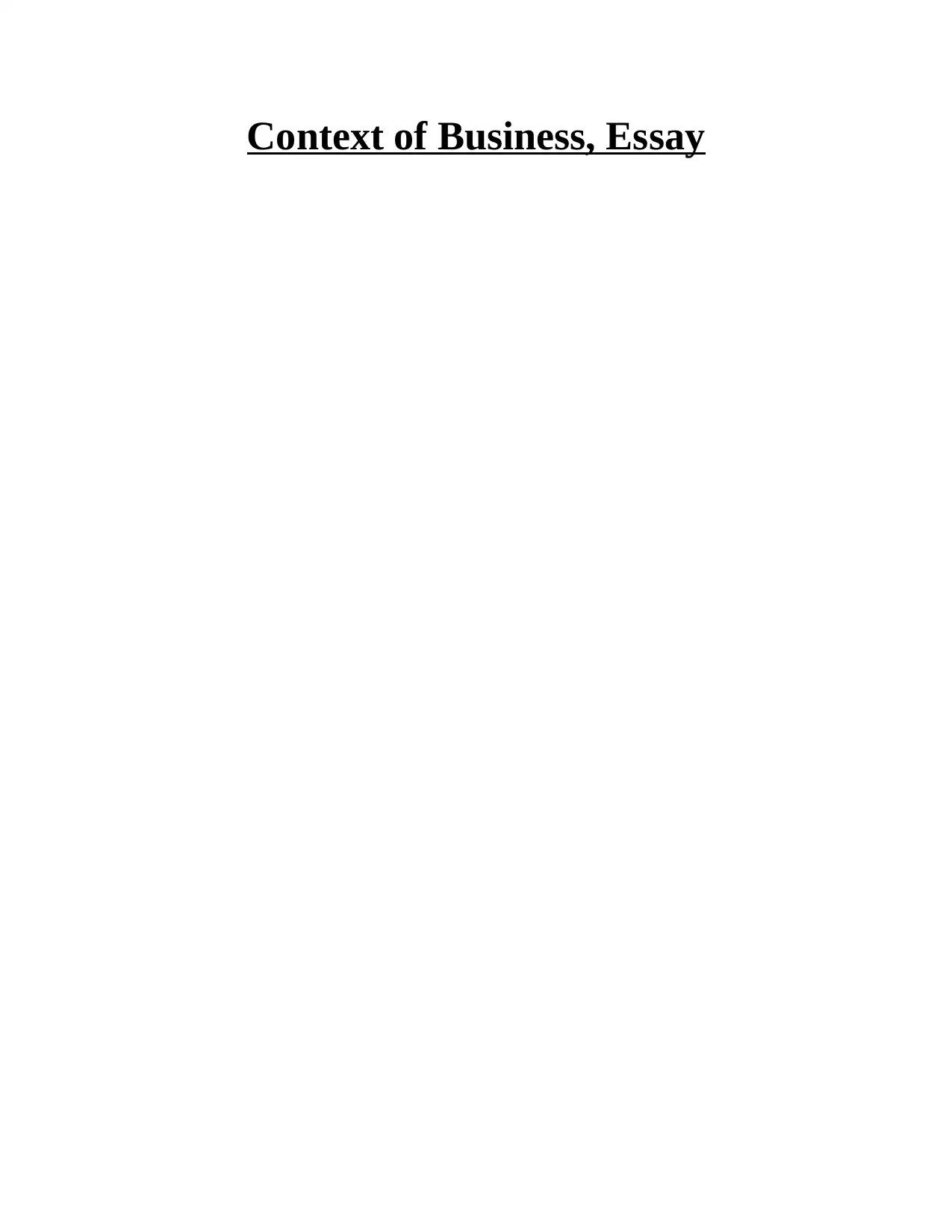
Context of Business, Essay
Paraphrase This Document
Need a fresh take? Get an instant paraphrase of this document with our AI Paraphraser
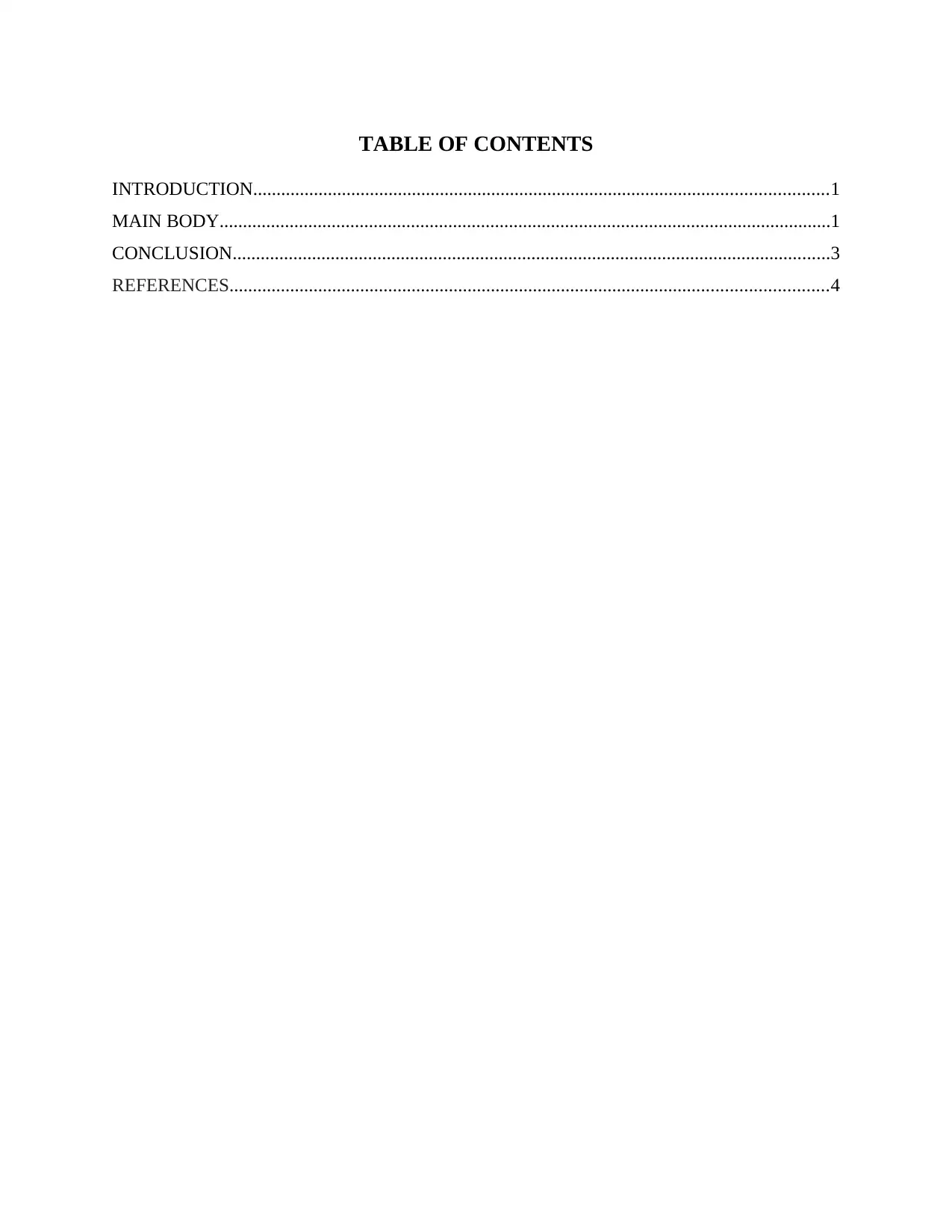
TABLE OF CONTENTS
INTRODUCTION...........................................................................................................................1
MAIN BODY...................................................................................................................................1
CONCLUSION................................................................................................................................3
REFERENCES................................................................................................................................4
INTRODUCTION...........................................................................................................................1
MAIN BODY...................................................................................................................................1
CONCLUSION................................................................................................................................3
REFERENCES................................................................................................................................4
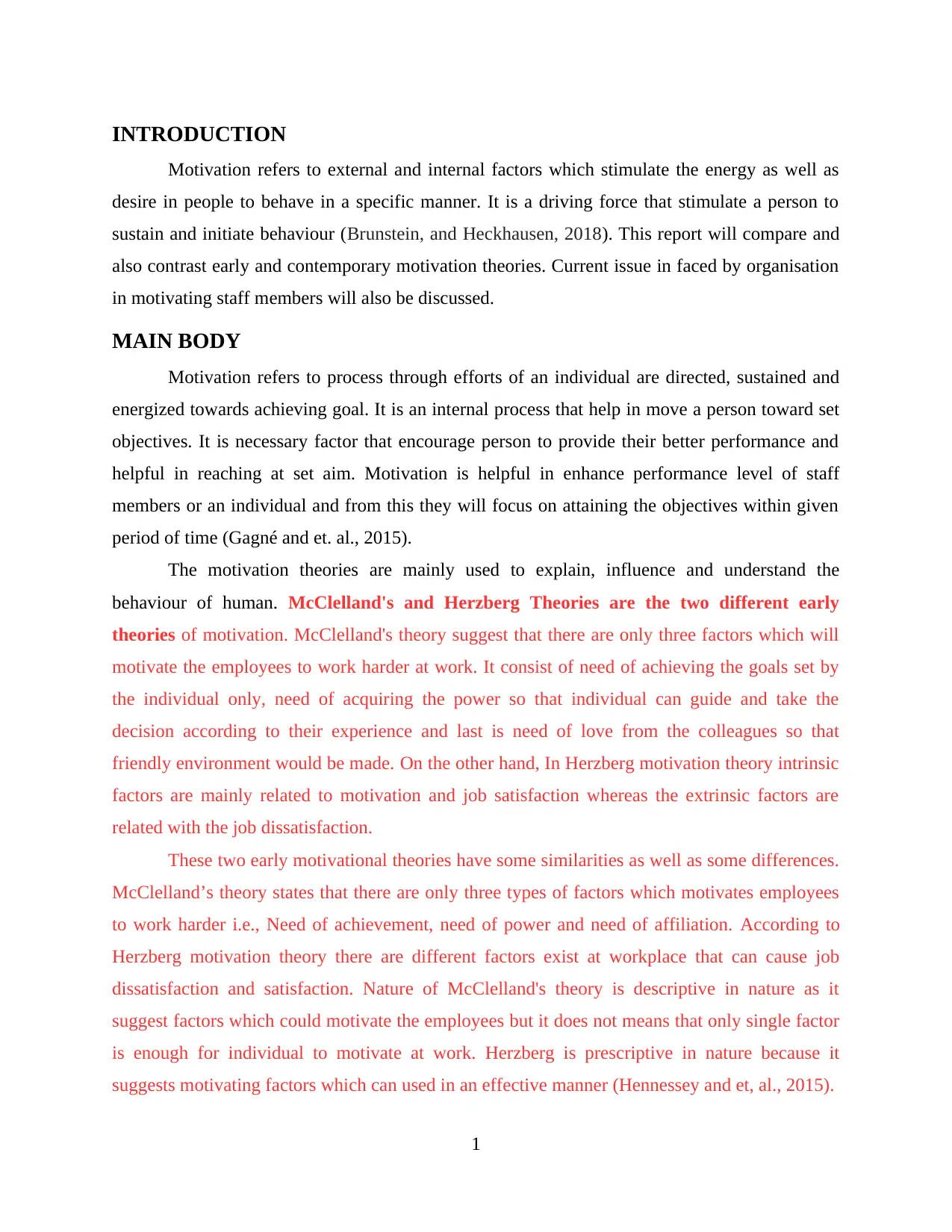
INTRODUCTION
Motivation refers to external and internal factors which stimulate the energy as well as
desire in people to behave in a specific manner. It is a driving force that stimulate a person to
sustain and initiate behaviour (Brunstein, and Heckhausen, 2018). This report will compare and
also contrast early and contemporary motivation theories. Current issue in faced by organisation
in motivating staff members will also be discussed.
MAIN BODY
Motivation refers to process through efforts of an individual are directed, sustained and
energized towards achieving goal. It is an internal process that help in move a person toward set
objectives. It is necessary factor that encourage person to provide their better performance and
helpful in reaching at set aim. Motivation is helpful in enhance performance level of staff
members or an individual and from this they will focus on attaining the objectives within given
period of time (Gagné and et. al., 2015).
The motivation theories are mainly used to explain, influence and understand the
behaviour of human. McClelland's and Herzberg Theories are the two different early
theories of motivation. McClelland's theory suggest that there are only three factors which will
motivate the employees to work harder at work. It consist of need of achieving the goals set by
the individual only, need of acquiring the power so that individual can guide and take the
decision according to their experience and last is need of love from the colleagues so that
friendly environment would be made. On the other hand, In Herzberg motivation theory intrinsic
factors are mainly related to motivation and job satisfaction whereas the extrinsic factors are
related with the job dissatisfaction.
These two early motivational theories have some similarities as well as some differences.
McClelland’s theory states that there are only three types of factors which motivates employees
to work harder i.e., Need of achievement, need of power and need of affiliation. According to
Herzberg motivation theory there are different factors exist at workplace that can cause job
dissatisfaction and satisfaction. Nature of McClelland's theory is descriptive in nature as it
suggest factors which could motivate the employees but it does not means that only single factor
is enough for individual to motivate at work. Herzberg is prescriptive in nature because it
suggests motivating factors which can used in an effective manner (Hennessey and et, al., 2015).
1
Motivation refers to external and internal factors which stimulate the energy as well as
desire in people to behave in a specific manner. It is a driving force that stimulate a person to
sustain and initiate behaviour (Brunstein, and Heckhausen, 2018). This report will compare and
also contrast early and contemporary motivation theories. Current issue in faced by organisation
in motivating staff members will also be discussed.
MAIN BODY
Motivation refers to process through efforts of an individual are directed, sustained and
energized towards achieving goal. It is an internal process that help in move a person toward set
objectives. It is necessary factor that encourage person to provide their better performance and
helpful in reaching at set aim. Motivation is helpful in enhance performance level of staff
members or an individual and from this they will focus on attaining the objectives within given
period of time (Gagné and et. al., 2015).
The motivation theories are mainly used to explain, influence and understand the
behaviour of human. McClelland's and Herzberg Theories are the two different early
theories of motivation. McClelland's theory suggest that there are only three factors which will
motivate the employees to work harder at work. It consist of need of achieving the goals set by
the individual only, need of acquiring the power so that individual can guide and take the
decision according to their experience and last is need of love from the colleagues so that
friendly environment would be made. On the other hand, In Herzberg motivation theory intrinsic
factors are mainly related to motivation and job satisfaction whereas the extrinsic factors are
related with the job dissatisfaction.
These two early motivational theories have some similarities as well as some differences.
McClelland’s theory states that there are only three types of factors which motivates employees
to work harder i.e., Need of achievement, need of power and need of affiliation. According to
Herzberg motivation theory there are different factors exist at workplace that can cause job
dissatisfaction and satisfaction. Nature of McClelland's theory is descriptive in nature as it
suggest factors which could motivate the employees but it does not means that only single factor
is enough for individual to motivate at work. Herzberg is prescriptive in nature because it
suggests motivating factors which can used in an effective manner (Hennessey and et, al., 2015).
1
⊘ This is a preview!⊘
Do you want full access?
Subscribe today to unlock all pages.

Trusted by 1+ million students worldwide
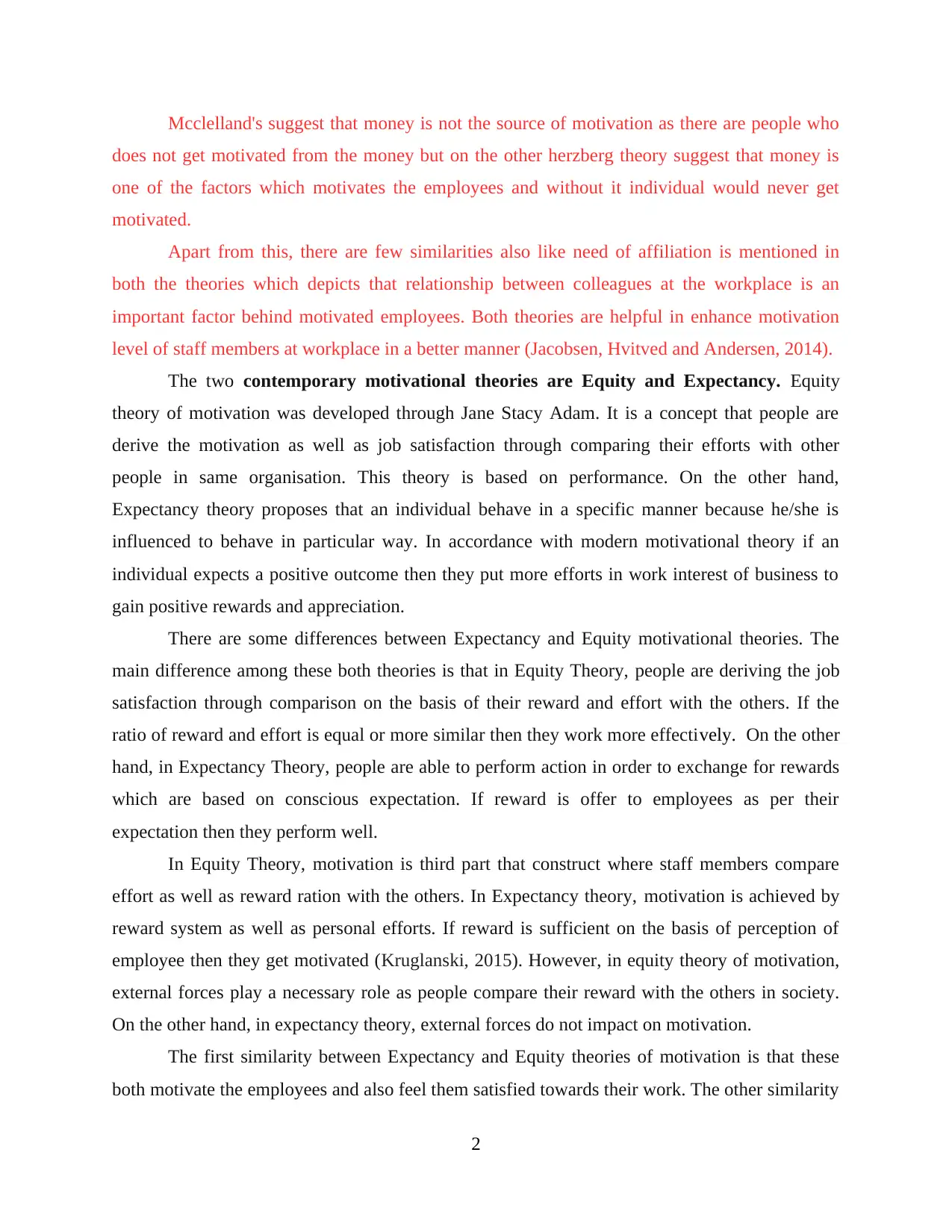
Mcclelland's suggest that money is not the source of motivation as there are people who
does not get motivated from the money but on the other herzberg theory suggest that money is
one of the factors which motivates the employees and without it individual would never get
motivated.
Apart from this, there are few similarities also like need of affiliation is mentioned in
both the theories which depicts that relationship between colleagues at the workplace is an
important factor behind motivated employees. Both theories are helpful in enhance motivation
level of staff members at workplace in a better manner (Jacobsen, Hvitved and Andersen, 2014).
The two contemporary motivational theories are Equity and Expectancy. Equity
theory of motivation was developed through Jane Stacy Adam. It is a concept that people are
derive the motivation as well as job satisfaction through comparing their efforts with other
people in same organisation. This theory is based on performance. On the other hand,
Expectancy theory proposes that an individual behave in a specific manner because he/she is
influenced to behave in particular way. In accordance with modern motivational theory if an
individual expects a positive outcome then they put more efforts in work interest of business to
gain positive rewards and appreciation.
There are some differences between Expectancy and Equity motivational theories. The
main difference among these both theories is that in Equity Theory, people are deriving the job
satisfaction through comparison on the basis of their reward and effort with the others. If the
ratio of reward and effort is equal or more similar then they work more effectively. On the other
hand, in Expectancy Theory, people are able to perform action in order to exchange for rewards
which are based on conscious expectation. If reward is offer to employees as per their
expectation then they perform well.
In Equity Theory, motivation is third part that construct where staff members compare
effort as well as reward ration with the others. In Expectancy theory, motivation is achieved by
reward system as well as personal efforts. If reward is sufficient on the basis of perception of
employee then they get motivated (Kruglanski, 2015). However, in equity theory of motivation,
external forces play a necessary role as people compare their reward with the others in society.
On the other hand, in expectancy theory, external forces do not impact on motivation.
The first similarity between Expectancy and Equity theories of motivation is that these
both motivate the employees and also feel them satisfied towards their work. The other similarity
2
does not get motivated from the money but on the other herzberg theory suggest that money is
one of the factors which motivates the employees and without it individual would never get
motivated.
Apart from this, there are few similarities also like need of affiliation is mentioned in
both the theories which depicts that relationship between colleagues at the workplace is an
important factor behind motivated employees. Both theories are helpful in enhance motivation
level of staff members at workplace in a better manner (Jacobsen, Hvitved and Andersen, 2014).
The two contemporary motivational theories are Equity and Expectancy. Equity
theory of motivation was developed through Jane Stacy Adam. It is a concept that people are
derive the motivation as well as job satisfaction through comparing their efforts with other
people in same organisation. This theory is based on performance. On the other hand,
Expectancy theory proposes that an individual behave in a specific manner because he/she is
influenced to behave in particular way. In accordance with modern motivational theory if an
individual expects a positive outcome then they put more efforts in work interest of business to
gain positive rewards and appreciation.
There are some differences between Expectancy and Equity motivational theories. The
main difference among these both theories is that in Equity Theory, people are deriving the job
satisfaction through comparison on the basis of their reward and effort with the others. If the
ratio of reward and effort is equal or more similar then they work more effectively. On the other
hand, in Expectancy Theory, people are able to perform action in order to exchange for rewards
which are based on conscious expectation. If reward is offer to employees as per their
expectation then they perform well.
In Equity Theory, motivation is third part that construct where staff members compare
effort as well as reward ration with the others. In Expectancy theory, motivation is achieved by
reward system as well as personal efforts. If reward is sufficient on the basis of perception of
employee then they get motivated (Kruglanski, 2015). However, in equity theory of motivation,
external forces play a necessary role as people compare their reward with the others in society.
On the other hand, in expectancy theory, external forces do not impact on motivation.
The first similarity between Expectancy and Equity theories of motivation is that these
both motivate the employees and also feel them satisfied towards their work. The other similarity
2
Paraphrase This Document
Need a fresh take? Get an instant paraphrase of this document with our AI Paraphraser
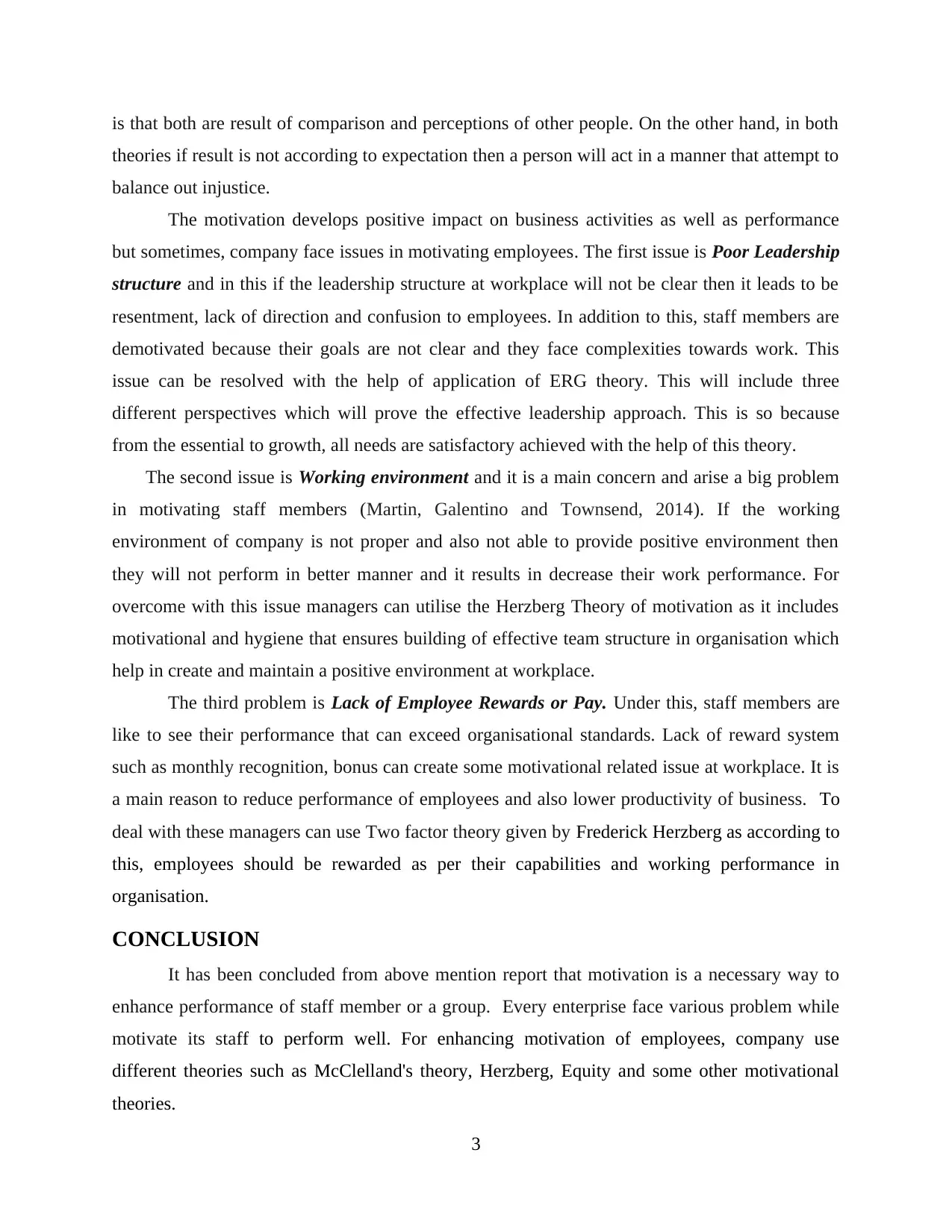
is that both are result of comparison and perceptions of other people. On the other hand, in both
theories if result is not according to expectation then a person will act in a manner that attempt to
balance out injustice.
The motivation develops positive impact on business activities as well as performance
but sometimes, company face issues in motivating employees. The first issue is Poor Leadership
structure and in this if the leadership structure at workplace will not be clear then it leads to be
resentment, lack of direction and confusion to employees. In addition to this, staff members are
demotivated because their goals are not clear and they face complexities towards work. This
issue can be resolved with the help of application of ERG theory. This will include three
different perspectives which will prove the effective leadership approach. This is so because
from the essential to growth, all needs are satisfactory achieved with the help of this theory.
The second issue is Working environment and it is a main concern and arise a big problem
in motivating staff members (Martin, Galentino and Townsend, 2014). If the working
environment of company is not proper and also not able to provide positive environment then
they will not perform in better manner and it results in decrease their work performance. For
overcome with this issue managers can utilise the Herzberg Theory of motivation as it includes
motivational and hygiene that ensures building of effective team structure in organisation which
help in create and maintain a positive environment at workplace.
The third problem is Lack of Employee Rewards or Pay. Under this, staff members are
like to see their performance that can exceed organisational standards. Lack of reward system
such as monthly recognition, bonus can create some motivational related issue at workplace. It is
a main reason to reduce performance of employees and also lower productivity of business. To
deal with these managers can use Two factor theory given by Frederick Herzberg as according to
this, employees should be rewarded as per their capabilities and working performance in
organisation.
CONCLUSION
It has been concluded from above mention report that motivation is a necessary way to
enhance performance of staff member or a group. Every enterprise face various problem while
motivate its staff to perform well. For enhancing motivation of employees, company use
different theories such as McClelland's theory, Herzberg, Equity and some other motivational
theories.
3
theories if result is not according to expectation then a person will act in a manner that attempt to
balance out injustice.
The motivation develops positive impact on business activities as well as performance
but sometimes, company face issues in motivating employees. The first issue is Poor Leadership
structure and in this if the leadership structure at workplace will not be clear then it leads to be
resentment, lack of direction and confusion to employees. In addition to this, staff members are
demotivated because their goals are not clear and they face complexities towards work. This
issue can be resolved with the help of application of ERG theory. This will include three
different perspectives which will prove the effective leadership approach. This is so because
from the essential to growth, all needs are satisfactory achieved with the help of this theory.
The second issue is Working environment and it is a main concern and arise a big problem
in motivating staff members (Martin, Galentino and Townsend, 2014). If the working
environment of company is not proper and also not able to provide positive environment then
they will not perform in better manner and it results in decrease their work performance. For
overcome with this issue managers can utilise the Herzberg Theory of motivation as it includes
motivational and hygiene that ensures building of effective team structure in organisation which
help in create and maintain a positive environment at workplace.
The third problem is Lack of Employee Rewards or Pay. Under this, staff members are
like to see their performance that can exceed organisational standards. Lack of reward system
such as monthly recognition, bonus can create some motivational related issue at workplace. It is
a main reason to reduce performance of employees and also lower productivity of business. To
deal with these managers can use Two factor theory given by Frederick Herzberg as according to
this, employees should be rewarded as per their capabilities and working performance in
organisation.
CONCLUSION
It has been concluded from above mention report that motivation is a necessary way to
enhance performance of staff member or a group. Every enterprise face various problem while
motivate its staff to perform well. For enhancing motivation of employees, company use
different theories such as McClelland's theory, Herzberg, Equity and some other motivational
theories.
3

4
⊘ This is a preview!⊘
Do you want full access?
Subscribe today to unlock all pages.

Trusted by 1+ million students worldwide
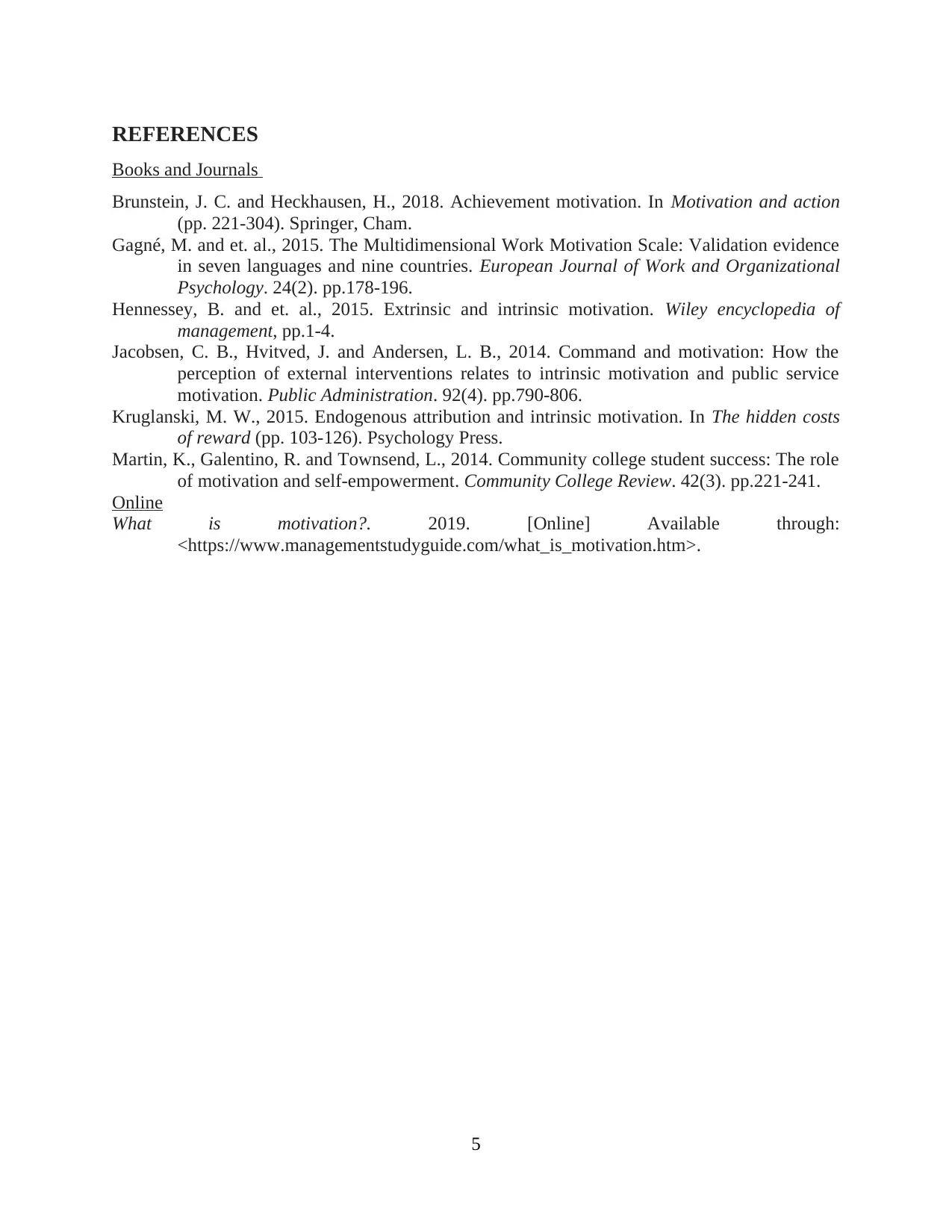
REFERENCES
Books and Journals
Brunstein, J. C. and Heckhausen, H., 2018. Achievement motivation. In Motivation and action
(pp. 221-304). Springer, Cham.
Gagné, M. and et. al., 2015. The Multidimensional Work Motivation Scale: Validation evidence
in seven languages and nine countries. European Journal of Work and Organizational
Psychology. 24(2). pp.178-196.
Hennessey, B. and et. al., 2015. Extrinsic and intrinsic motivation. Wiley encyclopedia of
management, pp.1-4.
Jacobsen, C. B., Hvitved, J. and Andersen, L. B., 2014. Command and motivation: How the
perception of external interventions relates to intrinsic motivation and public service
motivation. Public Administration. 92(4). pp.790-806.
Kruglanski, M. W., 2015. Endogenous attribution and intrinsic motivation. In The hidden costs
of reward (pp. 103-126). Psychology Press.
Martin, K., Galentino, R. and Townsend, L., 2014. Community college student success: The role
of motivation and self-empowerment. Community College Review. 42(3). pp.221-241.
Online
What is motivation?. 2019. [Online] Available through:
<https://www.managementstudyguide.com/what_is_motivation.htm>.
5
Books and Journals
Brunstein, J. C. and Heckhausen, H., 2018. Achievement motivation. In Motivation and action
(pp. 221-304). Springer, Cham.
Gagné, M. and et. al., 2015. The Multidimensional Work Motivation Scale: Validation evidence
in seven languages and nine countries. European Journal of Work and Organizational
Psychology. 24(2). pp.178-196.
Hennessey, B. and et. al., 2015. Extrinsic and intrinsic motivation. Wiley encyclopedia of
management, pp.1-4.
Jacobsen, C. B., Hvitved, J. and Andersen, L. B., 2014. Command and motivation: How the
perception of external interventions relates to intrinsic motivation and public service
motivation. Public Administration. 92(4). pp.790-806.
Kruglanski, M. W., 2015. Endogenous attribution and intrinsic motivation. In The hidden costs
of reward (pp. 103-126). Psychology Press.
Martin, K., Galentino, R. and Townsend, L., 2014. Community college student success: The role
of motivation and self-empowerment. Community College Review. 42(3). pp.221-241.
Online
What is motivation?. 2019. [Online] Available through:
<https://www.managementstudyguide.com/what_is_motivation.htm>.
5
Paraphrase This Document
Need a fresh take? Get an instant paraphrase of this document with our AI Paraphraser

6
1 out of 8
Related Documents
Your All-in-One AI-Powered Toolkit for Academic Success.
+13062052269
info@desklib.com
Available 24*7 on WhatsApp / Email
![[object Object]](/_next/static/media/star-bottom.7253800d.svg)
Unlock your academic potential
Copyright © 2020–2025 A2Z Services. All Rights Reserved. Developed and managed by ZUCOL.





